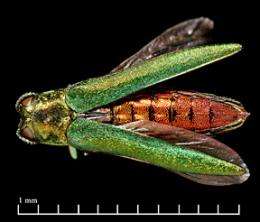Emerald ash borer. Image: Kent Loeffler/Cornell
Cornell University is leading efforts to manage outbreak populations of the emerald ash borer (EAB), a beetle that has the potential to devastate ash trees in the Northeast. The new invasive species is already in Steuben and Ulster counties. The pest first showed up in western New York last August in the Cattaraugus County town of Randolph.
"I knew it would be a matter of time until we would find the EAB at other sites in New York," said John Vandenberg, research entomologist with the U.S. Department of Agriculture Agricultural Research Service and adjunct professor of entomology, who discovered the EAB in New York state last summer. "What we discovered in Randolph last year were some rather heavily infested ash trees." He hopes, he added, that the new detections have been discovered early enough to prevent disastrous infestations.
Vandenberg, along with Mark Whitmore, a Cornell forest entomologist, and Melissa Fierke of the State University of New York College of Environmental Science and Forestry are working extensively with Cornell Cooperative Extension offices throughout New York to raise public awareness about the EAB to minimize the ecological, social and economic impacts of the destructive pest.
While the bright green beetles cause no direct harm to humans, they can kill a North American ash tree in two to three years. The beetles threaten the Northeast's hardwood forests and are a major potential liability to communities, says Whitmore, because removing dead or infested trees costs $2,000 to $3,000 per tree. "Every penny we spend now will be paid back many times over in cost saving," he said, recommending that communities conduct an urban tree inventory and begin to lay out realistic plans for the eventual arrival of the EAB.
To keep the EAB from spreading, the team has been strategically killing and removing infested ash trees to decrease the EAB population and use for research.
With expected emergency funding from the Farm Bill, the team is considering identifying potential high-risk areas and perhaps importing several natural predator species of Chinese parasitic wasps if research proves them effective, said Vandenberg. "Meanwhile, we would have time to look for additional natural enemies, develop ash resistance or find other measures," he said.
Losing ash trees would not only mean major losses to lumber companies, said Tom Gerow of Wagner Lumber in Owego, N.Y., but a massive loss of ash trees would cause overharvest of other tree species and a failure of forests to replenish the lost valuable species. "Ash trees represent 10 percent of New York forests," said Gerow. "The 'void' will most likely be filled by plant species that reduce the environmental and societal benefits that forests have to offer."
The EAB, a native of Asia, is believed to have made its way to the United States through wooden shipping crates. Since first detected in North America in 2002 near Detroit and southern Ontario, the EAB has since spread, likely via infested ash firewood, to 13 states and two Canadian provinces, killing hundreds of millions of ash trees. To discourage such spread of invasive species, New York enacted firewood regulations in May 2009, which prohibits the transport of untreated firewood beyond 50 miles. Consumers should only use firewood from local sources and never move firewood from dying trees.
Provided by Cornell University





















